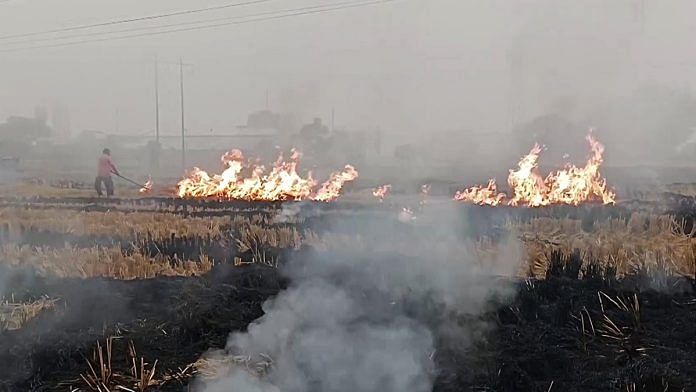
New Delhi: Pollution control bodies are left scratching their heads this season. One of the reasons is that while satellite images show a significant decline in the stubble fires over the agrarian states of Punjab, Haryana and Uttar Pradesh, pollution levels in these regions have seen no respite. An analysis of American and South Korean satellite images shows that farmers may have cracked the code of outwitting satellites.
Hiren Jethva, a senior aerosol remote sensing scientist with the NASA Goddard Space Flight Center, said that farmers in northwest India and Pakistan could be avoiding the satellite overpass time (when the field of view of a satellite’s instrument passes over an area of interest) to evade detection and subsequent penalties. This, he explained, is only giving an impression of the decreasing stubble fire count while, in reality, farmers are only altering the timing of setting their fields on fire. “Are farmers in NW India and Pakistan avoiding satellite overpass time for stubble burning? A close eyeballing of GEO-KOMPSAT 2A geostationary satellite images show localized puffs/clouds of smoke in late afternoon.

Needs ground checking,” Jethva wrote on X on 25 October. Are farmers in NW India and Pakistan avoiding satellite overpass time for stubble burning ? A close eyeballing of GEO-KOMPSAT 2A geostationary satellite images show localized puffs/clouds of smoke in late afernoon. Needs ground checking.
pic.twitter.com/625gDs1ecD — Hiren Jethva (@hjethva05) October 24, 2024 Also Read: US biologists win Nobel in Medicine for microRNA discovery.
Here’s how it prevents diseases like cancer Jethva explained to ThePrint that NASA satellites like the Suomi National Polar-orbiting Partnership (Suomi NPP) and the Aqua Earth-observing satellite usually overpass northwest India and Pakistan at around 1.30 to 2 pm. Based on images taken by satellites during their overpass time, scientists ascertain the trends of the burning activities in the area.
However, on analysing images from South Korea’s geostationary satellite GEO-KOMPSAT-2A (GK2A)—owned and operated by the Korea Aerospace Research Institute—which consistently takes pictures of a region every five minutes, Jethva found that farm fires have now merely shifted to post-afternoon hours. “The images from the GEO-KOMPSAT-2A satellite show how farm fires are now peaking around late afternoon. This can be seen as localised smoke clouds over the region.
The question now is: who is educating farmers to change their patterns and why?” he asked. He said a preliminary quantitative analysis of the GK2A-AMI (advanced meteorological imager) sensor’s 3.8-micron data indicated that fire activity peaked late afternoon over the past three years.
The NASA scientist also claimed that while government data shows a consistent, year-on-year decline in stubble fires in Punjab and Haryana, there has not been any significant reduction in aerosols in air, also indicating rampant burning. “If there is a reduction in fire counts, there should also be a reduction in the presence of smoke in the atmosphere. This has not happened,” he said.
Data released by the Indian Agricultural Research Institute (IARI)’s Consortium for Research on Agroecosystem Monitoring and Modeling from Space (CREAMS) showed that between 15 September and 5 November, Punjab recorded 4,755 farm fires, and Haryana 857. Data from the Union environment ministry indicates a decline in stubble fires in Punjab and Haryana. In 2023, Punjab reported 36,663 stubble fires, down from 49,922 in 2022.
Similarly, Haryana recorded only 2,303 stubble fires in 2023, down from 3,661 in 2022. While data shows a decreasing trend, the Supreme Court has called out officials from Punjab and Haryana for their reluctance to take action against farmers for indulging in stubble burning. Every year between October and November, thick smoke from stubble fires is carried to Delhi with winter winds, setting the stage for the capital’s annual winter pollution season.
This year, higher-than-normal October temperatures and high wind speeds have saved Delhi’s air from entering the ‘severe’ category. Authorities, however, denied the allegations made by Jethva. Professor Ravindra Khaiwal, an expert on public and environmental health and air pollution from Post Graduate Institute of Medical Education and Research (PGIMER) in Chandigarh, called these claims “unsubstantiated”.
“Over 95 percent of fires are detected in morning passes, not evening. The reduction in fire counts is likely due to improved enforcement and alternative practices,” he wrote on X. (Edited by Radifah Kabir) Also Read: 2024 Physics Nobel for AI scientists.
How they pioneered machine learning modelled on human brain Punjab and Haryana farmers have become a nuisance for the nation. There was a time when the entire nation used to take pride in the achievements of the Punjab farmer. Unfortunately, now he is just a burden on the nation.
Woefully unproductive and totally dependent on state MSP. Save my name, email, and website in this browser for the next time I comment. Δ document.
getElementById( "ak_js_1" ).setAttribute( "value", ( new Date() ).getTime() );.














